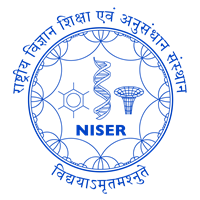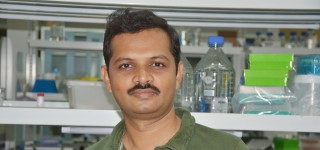

Associate Professor
rudresh.acharyaniser.ac.in
+91-674-2494000 > 2220
Postdoctoral. University of Pennsylavnia Medical School (2006-2011). Adviser: Prof. William F. DeGrado
Ph.D. Bio-Crystallography, IISc, Bangalore (2006). Department of Physics, Adviser: Prof. S. Ramakumar
M.Sc. Physics, (1998) Christ College, Bangalore
Macromolecular X-ray Crystallography, Structural Biology, De novo protein design
Ramalingaswami fellowship DBT, India (2012)
IBM Best CAS Students Award (2007)
Jeffery Award given by the Pittsburg diffraction society at XIX Congress and General Assembly of International Union of Crystallography, Geneva (2002)
[Selected Publications]
From NISER
Smitha Mohanlal#, Diprupa Saha, Shubhant Pandey, Rudresh Acharya# and Nagendra K. Sharma# Synthesis of R-GABA Derivatives via Pd(II) Catalyzed Enantioselective C(sp3)-H Arylation and Virtual Validation with GABAB1 Receptor for Potential leads, Chemistry An Asian Journal, 2024, (doi:10.1002/asia.202400064)
Shubhant Pandey, Bryan W. Berger#, and Rudresh Acharya#, Structural Analyses of Substrate−pH Activity Pairing Observed across Diverse Polysaccharide Lyases, Biochemistry, 2023, 62(18), 2775-2790 (doi:10.1021/acs.biochem.3c00321)
Prerana Dash and Rudresh Acharya#, Distinct Modes of Hidden Structural Dynamics in the Functioning of an Allosteric Polysaccharide Lyase, ACS Central Science, 2022, 8(7), 933-947
Shubant Pandey, Pranjal Mahanta, Bryan W. Berger#, Rudresh Acharya#, Structural insights into the mechanism of pH-selective substrate specificity of the polysaccharide lyase Smlt1473, Journal of Biological Chemistry, 2021, 297,101014 (PMID: 34358563, DOI: 10.1016/j.jbc.2021.101014)
Kook-Han Kim, Dong-Kyun Ko, Yong-Tae Kim, Nam Hyeong Kim, Jaydeep Paul, Shao-Qing Zhang, Christopher B. Murray, Rudresh Acharya#, William F. DeGrado#, Yong Ho Kim# & Gevorg Grigoryan# Protein-directed self-assembly of a fullerene crystal Nature communications, 2016 7:11429 | DOI: 10.1038/ncomms11429 [#corresponding author]
Nathan H. Joh, Tuo Wang, Manasi P. Bhate, Rudresh Acharya , Yibing Wu, Michael Grabe, Mei Hong, Gevorg Grigoryan, and William F. DeGrado De novo design of a transmembrane Zn2+-transporting four-helix bundle Science, 2014 346(6216):1425-1588
During Postdoc and PhD
Gevorg Grigoryan*, Yong Ho Kim*, Rudresh Acharya, Kevin Axelrod, Rishabh M. Jain, Lauren Willis, Marija Drndic, James M. Kikkawa, William F. DeGrado Computational design of virus-like protein assemblies on carbon nanotube surfaces Science,2011 332(6033):1071-1076. *equally contributed
Rudresh Acharya*, Vincenzo Carnevale*, Giacomo Fiorin*, Benjamin G. Levine*, Alexei L. Polishchuk*, Victoria Balannik, Ilan Samish, Robert A. Lamb, Lawrence, H. Pinto, William F. DeGrado, Michael L. Klein. Structure and mechanism of proton transport through the transmembrane tetrameric M2 protein bundle of the influenza A virus Proc. Natl. Acad. Sci. USA, 2010107(34):15075-15080. *equally contributed
Amanda L. Stouffer*, Rudresh Acharya*, David Salom*, Anna S. Levine, Luigi Di Costanzo, Cinque S. Soto, Valentina Tereshko, Vikas Nanda, Steven Stayrook, William F. DeGrado. Structural basis for the function and inhibition of an influenza virus proton channel Nature, 2008 451(7178):596-599. *equally contributed
Rudresh, Suryanarayanarao Ramakumar, Udupi A. Ramagopal, Yoshihito Inai, Suchi Goel, Dinakar Sahal, Virander S. Chauhan. De novo design and characterization of a helical hairpin eicosapeptide; emergence of an anion receptor in the linker region. Structure, 2004 12(3):389-396.
[#corresponding author]
[* first author]
Structural biology of soluble and transmembrane proteins, and De novo design of proteins.
Proteins are workhorses of a cell, engaged in a wide range of tasks comprising structural stability, cell signaling, catalysis, transporting, molecular printing, membrane fusion, regulation, etc. Understanding the mechanism that underlies the functioning of these molecular gadgets is an intriguing question, and defines the fundamentals of biological processes. This is an interdisciplinary research program as we set out to address the question using X-ray crystallographic methods coupled with biophysical, biochemical and computational approaches.
Our structural biology group aim to deduce the structure based mechanism for the functioning of cation selective channels from viruses. The structures not only enhance our current knowledge, but also provide leading point for the structure based drug design. Also, we are interested in the structural biology of bacterial two component systems, a wide spread signal transducers.
Our other research program is de novo protein design, which aim to put our understanding of principles that define protein folding and functioning into test. Here, we seek to design scaffolds that are tailored to have predetermined non-covalent interactions as well as functions.